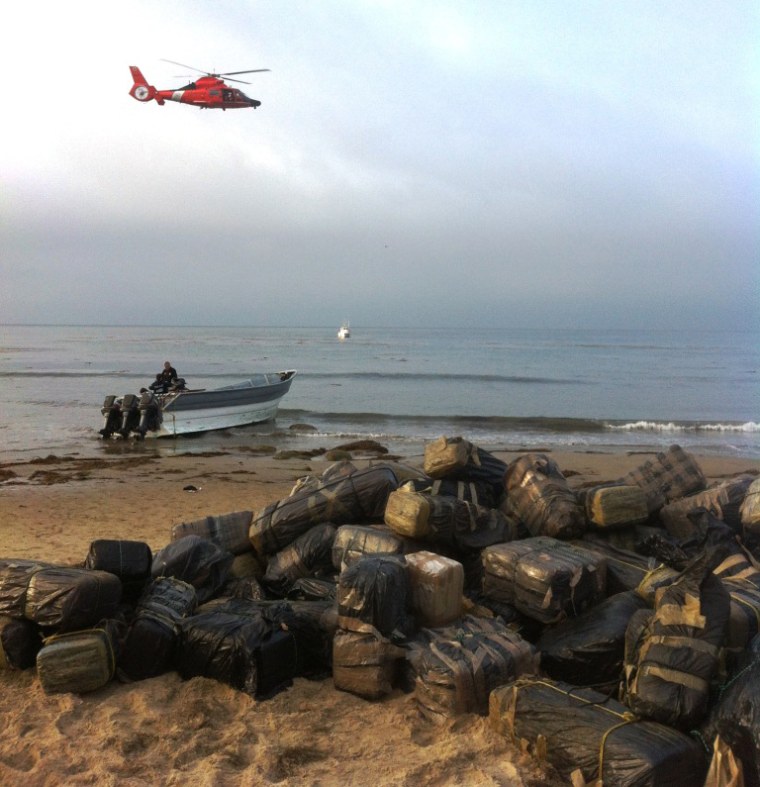By Mark Potter, Correspondent, NBC News
SANTA BARBARA, CALIF. -- Standing on a bluff along the central California coast, rancher Paul Van Leer pointed to the beach near his property where a Mexican smuggling boat, known as a panga, came ashore in May loaded with marijuana.
“The concern for me is that you’re bringing in a criminal element here that previously was never here before,” he said. “The criminal element is coming from Mexico in the boats and then they hire people from L.A. to transport the drugs once they land on the beach.”
The rancher's safety concerns reflect a trend noticed by federal and local law enforcement officials -- that Mexican maritime smugglers are bringing their illicit cargo farther and farther north along the California coast.
“We anticipate that trend to increase, because right now is a [Mexican] marijuana harvest, so we expect to have more vessels coming up,” said Claude Arnold, Special Agent in Charge of Homeland Security Investigations.

Recently, Mexican boats carrying marijuana loads have landed on remote shores more than 300 miles north of San Diego. Two pangas were found near Big Sur. Another landed on the secured beaches of Vandenberg Air Force Base, while other smugglers left $4 million worth of marijuana bales strewn along the beaches near Refugio State Park, close to the pricey homes there.
A National Park threat
Federal law enforcement officials say the maritime smugglers set sail from Mexico’s Baja Peninsula, south of Tijuana. Most of the pangas carry lucrative marijuana loads, but many also ferry immigrants hoping to sneak into the United States. Recently, the Mexican Navy announced it is finding about 150 migrants a month on an average of 10 to 12 boats.
“These folks are out there without life jackets, without signaling devices, without radios, so if anything were to happen it would be a major tragedy, it would be a severe loss of life,” said Lt. Commander Casey Hehr, Chief of Law Enforcement for the U.S. Coast Guard sector in Los Angeles-Long Beach.
While most of the Mexican immigrant smugglers drop off their human cargo loads in southern California near San Diego, the marijuana smugglers are traveling farther north to avoid detection.
For the last three years, some of the smugglers have been using the Channel Islands National Park, a chain of environmentally sensitive islands off the Ventura and Santa Barbara coastlines, to refuel or to hide from U.S. Coast Guard patrols.
In 2010, a panga loaded with 2500 pounds of marijuana landed on Santa Rosa Island. A year later, 16 undocumented migrants were dropped off on Santa Cruz Island. Smugglers have also dumped fuel canisters in the Channel Islands.
The most dramatic and tragic incident occurred last December in Smugglers Cove, off Santa Cruz Island. Authorities say two suspected smugglers on a panga rammed a Coast Guard inflatable boat as it was approaching them, killing Chief Petty Officer Terrell Horne.
“The vessel increased speed, directly rammed the Coast Guard small boat,” said Hehr. “At that point two Coast Guard members were ejected into the water. Senior Chief Horne was actually killed by the panga as he went into the water.”
Two suspects were arrested shortly afterward and now await trial.
Park officials say with more than a half-million visitors to the Channel Islands every year, they worry about the possibility of smugglers confronting tourists, although so far that hasn’t occurred.
“It’s unfortunate this type of criminal activity is happening in a national park and in an area where people come to take refuge from their life and to experience relaxation,” said Yvonne Menard of the National Park Service.
Federal agents moving north
Law enforcement officials said the rise in Mexican maritime smuggling is a direct result of the increased security along the land border between the U.S. and Mexico, which is forcing smugglers to find new routes.
Since October, officials reported nearly 140 smuggling incidents along the California coast, a slight increase from this time last year.
With smugglers heading farther north, the U.S. Department of Homeland Security has started a San Francisco-area task force to make sure federal, state and local officials there work together to interdict the pangas. The California National Guard also does surveillance flights, as agents on the ground try to infiltrate the Mexican smuggling groups that use the pangas.
“It’s great to arrest the captains of the boats and punish them criminally and lock them up, but ultimately that’s not going to stop or disrupt the activity like it will when you go after the organization or the head of the organization,” said Arnold.
Ranchers Susie and Mark Tautrim, whose coastal property is north of Santa Barbara, said smugglers used a storm water drainage tunnel to walk from the beach to their land in July of 2012. Police informed the Tautrims they found footprints and wet clothing there.
“It’s very frightening to think that they’re on your land,” said Susie. “Those kinds of people can be very desperate and that’s what scares me.”
Despite increased numbers of smuggling arrests and indictments, law enforcement officials said they see no signs of the Mexican traffickers slowing down their activities. In fact, some are now using recreational boats, rather than pangas, to more effectively hide their illicit loads.
“The operators have become more brazen,” said Hehr. “These organizations that are smuggling in drugs, migrants and who knows what else are dangerous individuals.”